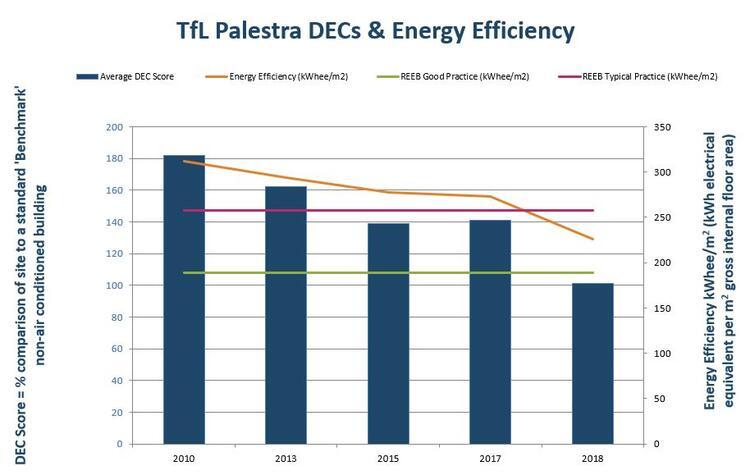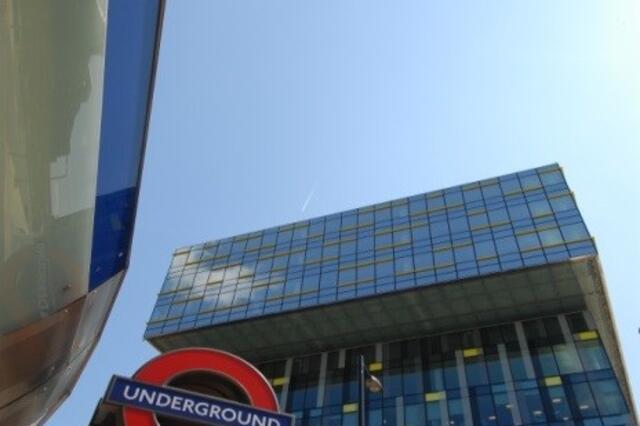TfL Partnership with E.ON Transforms Performance at Palestra
12 April 2019TfL Partnership with E.ON Transforms Performance at Palestra
12 April 2019Transport for London (TfL) has completed a major RE:FIT project with E.ON and specialist partners to improve energy efficiency at its Palestra hub. Cost savings and CO2 reductions in the first year significantly exceeded E.ON’s performance guarantees and improvements have also helped improve occupant satisfaction.
Key Facts
- £445,000 annual energy cost savings
- 17% reduction in CO2 emissions vs the measurement and verification baseline
- Greater occupant satisfaction
- Automatic operation of CCHP for first time in 10 years
- Shortlisted for three awards
Situation
Palestra is a large, complex building that provides accommodation for people and technology essential to keeping London’s transport network running 24/7. TfL had already raised the building’s BREEAM sustainability rating from Very Good to Excellent, after acquiring the head lease in 2008. Building features include a tri-generation combined cooling, heating and power (CCHP) system; a solar PV installation on the roof; micro wind turbines; efficient T5 lighting; rainwater harvesting; and a hydrogen fuel cell.
When TfL took full occupancy of the building in 2013 (taking on two further floors after the London Development Agency moved out), it reconfigured electrical infrastructure to allow for additional control rooms. It also commissioned Verco to investigate why the original tri-generation CCHP was not operating as originally anticipated.
Verco’s study identified several design and commissioning issues that impacted operational efficiency and building performance, including:
- Domestic hot water (DHW) required a two-hour recharge, resulting in insufficient hot water for showers at peak times and, therefore, affecting the many people who cycle and run to work at TfL.
- Waste heat from the gas-powered combined heat and power (CHP) engine passed through the thermal store first, so it could not be used appropriately.
- Electrical demand on the CHP’s twinned single transformer (of a total of four feeding the building) was insufficient for out-of-hours operation.
Informed by this review, the CCHP system was turned off while TfL investigated solutions.
In 2015, TfL appointed E.ON to carry out an energy performance contract, through the Greater London Authority’s RE:FIT programme. E.ON’s solution guaranteed savings of at least £111,000 a year and an 8% reduction in CO2 emissions. Importantly, it could be retrofitted without any downtime for the building’s 24/7 operations.
Actions
E.ON’s project works focused mainly on improving the efficiency and operations of existing technologies in the building, such as the whole CCHP system and DHW, as well as optimising building management systems (BMS) controls.
Key actions included:
- Revising pipework design so excess heat from low temperature hot water (LTHW) is used by building systems first, such as air handling units, on-floor fan coil units (FCUs) and DHW supply plate heat exchangers, before passing through to the thermal store.
- Loading up the CCHP’s twinned transformer (TX3) with 24/7 operational floors’ electrical loads (circa 160kW) and installing an additional modulating electric chiller.
- Linking the energy management system to the BMS so the electrical demand for the CCHP can be kept above its 417kW minimum output for as long as possible to maximise whole CCHP system run time and avoid any electrical export.
- Recommissioning the absorption chiller and associated cooling tower controls to provide consistent 24/7 heat demand for the gas CHP, while avoiding boiler heat being used to run the absorption chiller. This also reduced the electricity demand of the six other traditional electrical chillers, thus improving the cooling system’s overall carbon footprint.
- Replacing the 700-litre DHW calorifiers with plate heat exchangers and 800-litre buffer vessels. This allows the thermal store to meet the building’s DHW demand and to run heating for longer during the night without CCHP or boiler input, e.g. when there is not enough electrical demand to run the gas CHP or during CCHP system maintenance periods. They also now provide almost unlimited hot water to users on site, whereas the old calorifiers required two hours to regenerate their tanks, which led to poor hot water during peak periods.
- Replacing obsolete 2005 base build installed BMS controllers, communication network and software, to provide a more comprehensive and robust control system for the building management team to better manage the HVAC systems for occupant comfort.
- Recommissioning two floors of FCUs that provide heating and cooling within the office space, to eliminate issues of simultaneous heating and cooling found by E.ON during their investigations. This helped reduce energy consumption, as well as improve temperature control, enhancing staff wellbeing and reducing complaints. This has set out a model for future floors once further funds become available.
Financials
- £1,590,000 total project costs, including the E.ON energy performance contract and BMS upgrades.
- £445,000 savings in the year to February 2019, exceeding £111,000 performance guaranteed by E.ON.
Benefits
Results at the end of the first year:
- D-rated Display Energy Certificate (DEC) score of 99, a 30% improvement from F-rated score of 141 in 2017 (46% improvement vs G-rated score of 182 in 2010).
- 17% reduction in CO2 emissions vs 2017, exceeding 8% CO2 reduction guaranteed by E.ON and saving 784 tonnes of CO2 annually (38% improvement vs 2010).
- 13% better energy efficiency than the Real Estate Environmental Benchmark (REEB) typical practice. This is a 28% improvement from 2010.
- Greater occupant satisfaction, with lack of hot water no longer an issue on the daily Yammer feed. Secure hot water supply also encourages active commutes, contributing to people’s health and wellbeing, and reducing emissions from travel.
- Improved temperature management on office floors and in control rooms, supporting TfL’s efforts to enhance health and wellbeing, while reducing energy and emissions.
- Supporting the Mayor of London’s target to cut CO2 emissions by 60% by 2025.
- Shortlisted for three awards in 2018/19: Energy Live Awards ‘Energy Savers of the Year’ and CIBSE Building Performance Awards ‘Project of the Year Public Use’ and ‘Collaborative Working Partnership’, and assisted the wider TfL head office portfolio in winning the ‘FM Team of the Year’.

Challenges and Achievements
PARTNERSHIP
How to bring together multiple stakeholders on a complex project?
From the outset, the BSRIA Soft Landings provided a framework for all parties to work collaboratively on improving the building’s operational performance. A clear communication process and long-term commitment from all project partners were key to success, with everyone working together to deliver a lasting solution. E.ON’s energy solutions team engaged with TfL’s Environmental Manager early on to understand the fundamental issues. E.ON then brought in specialist partners to design and deliver appropriate solutions. Ramboll analysed the base build, identifying issues and designing potential solutions. Megan Mechanical Services delivered the complex pipework changes. A&O Engineering Design commissioned the systems. Other specialist providers working with TfL, such as CarbonCulture and AECOM, have been involved in developing a ‘live’ DEC to help publicise the success of the project. All subcontractors attended regular site meetings at Palestra, driven by TfL’s dedicated Project Manager, initially to understand the issues and later to assess solutions. Ramboll’s designs were also reviewed in detail at workshops involving TfL and key London Underground power stakeholders.
FUTURE
How low can we go?
TfL’s Environmental Manager is keen to maintain the sub-100 D-rated DEC score at Palestra. This is a great achievement as a 100 score is comparable to a non-fully air conditioned, mixed mode, standard occupancy density building. Upcoming efficiency plans include:
- Removing two 10-year old uninterruptible power supplies (UPSs) and reconfiguring their supplies to five-year old basement UPSs (given both sets were poorly designed and are currently running at circa 11% loading).
- Replacing the basement UPSs with new modular self-managing UPSs to enable TfL to access Demand Response market income streams.
- Upgrading the power resilience switching system on site to enable it to provide further electric load to the CHP out of normal office hours, which, coupled with the above, is projected to save a further £110,000 annually.
- Implementing auto power downs of non-critical IT infrastructure when not in use.
TfL is also investigating opportunities to recommission the fuel cell, following the purchase of the only spare stack for the model from an unused site elsewhere in the UK, and coupling its use with second-life electric vehicle batteries for energy storage. This would enable further Demand Response opportunities, both from reducing energy use at peak times / supplying excess capacity back to the Grid, and also from absorbing power from the Grid during periods of excess Grid capacity, thereby easing both these pressures on the Grid.
*Please note that the information on this page was supplied by the BBP Member and the BBP assumes no responsibility or liability for any errors or omissions in the content
